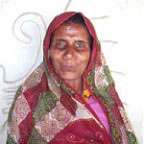JWDC
(please click the BACK button
on your browser to return to the painting)
|
ARTIST BIOGRAPHY: Anuragi Jha |
||
What
am 1-40, 50, 60? Let's say I'm fifty five years old. It tells on my
citizenship card. In
those days when I began school we used a board painted black and a stick
of mud for writing. I was just learning the alphabet when one day my
friends and I burst into laughter at something the teacher said. He hit
me hard on the cheek and when my grandfather who was also a teacher saw
my swollen face he fired that teacher, saying his blow was an insult to
our prestige. So our prestige wasn't lost -- but
I lost my life. When another teacher came to the village, they
didn't let me go, back to school with my four brothers. One
day someone came selling cloth parrots which we dangle over a child to
amuse him. I was fascinated by those parrots and took one into my
father's eggplant field and dissected it. Having seen how it was stuffed with leaves and sewn, I began to make my own.
That's why I like
parrots so much. I also made them by flattening mud between two leaves
which left their imprint on the body of the bird. And I drew them in
sand, and then I learned how to make arapan (ritual rice paste designs)
from my grandmother. My
grandmother was known for her arapan, and whoever was having a
haircutting ceremony or a marriage would ask her five days in advance to
paint for them. This made my grandfather, who said she should spend her
time preparing food, angry with her, but she said, what am I supposed to
do, cut off my hands? We
lived near Saurat where every year there's a big fair where fathers meet
to arrange the marriages of Brahman boys. At the fair my father
suggested to a friend to bring his son to marry me. That night at our
house they came to discuss the marriage. My husband wore earrings,
bracelets and a necklace with Hanuman. The next morning we were married.
I was eleven years old. At
that time I had no idea what marriage meant. I'd always played and worn
few clothes. When they put me in a sari I tripped and fell. The first
night we were put in a room together my husband was too shy to talk. I
asked him, "Do you have land? How far have you studied?" I
cried when I heard he hadn't studied at all -- his village had no school. Four
years later I moved to his village. At that time, my husband slept with
his father and I slept with his sister, until the time his sister was
married and left for her husband's house. My first child was born when I
was 16, and later I had three more. At
my husband's house I decorated the walls for his sister's wedding the
way I'd learned from my grandmother. I made my paints from dung, bean
leaves, and other plants, and I mixed them with milk. After that women
came at night to see my paintings -- we weren't allowed to go out during
the day. It
was at the time of my marriage that I decided that doing worship was
important. I had worshipped Mahadev (Shiva) for husband and quickly I'd
received one. I believed if I'd worshipped harder, I might have been
given an educated husband. So I worshipped more and more so that my
children would study -- if they didn't, what would happen to them? I
also became religious because my grandparents had taken me to a dance
for Krishna. I had the faith then that Krishna would stay with me. And
so it is with my paintings -- I believe if I show gods in my paintings
then everything in my life will turn out all right. It's just like the
story of Meera. One day Meera had seen a wedding party pass and asked
her mother when she could have a husband. Her mother pointed to a
picture on the wall of Krishna and told her that he was Meera's husband.
She believed this and therefore worshipped Krishna. Later when her
parents wanted to marry her off, she said, I am already married to
Krishna. After she was forced to marry, her new in-laws were unhappy
that she spent so much time in worship.
They put a snake in the pot that she used to worship and hoped it would
kill her. But when Meera opened the pot during her rituals, there was a
necklace of flowers. In
painting is faith that there will be no pain. For one thing, I earn
money so that I can afford to worship at the temple each day and to make
pilgrimmages. If I didn't have this work, I would spend my day praying.
Going to the temple is the most important thing. But since I must work,
why not do my worship by painting gods at the center? The
god I love the most is Hanuman. He is the strongest of the gods.
You can identify my paintings because of the gods, but also
because I fill in the space completely. I have to concentrate to make
sure colors alternate properly. In many paintings I also draw parrots
and elephants because these bring happiness. |
